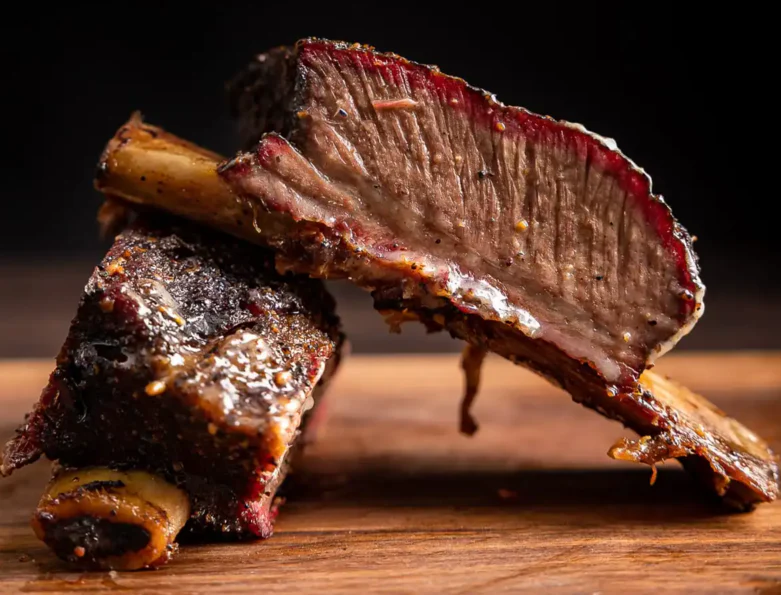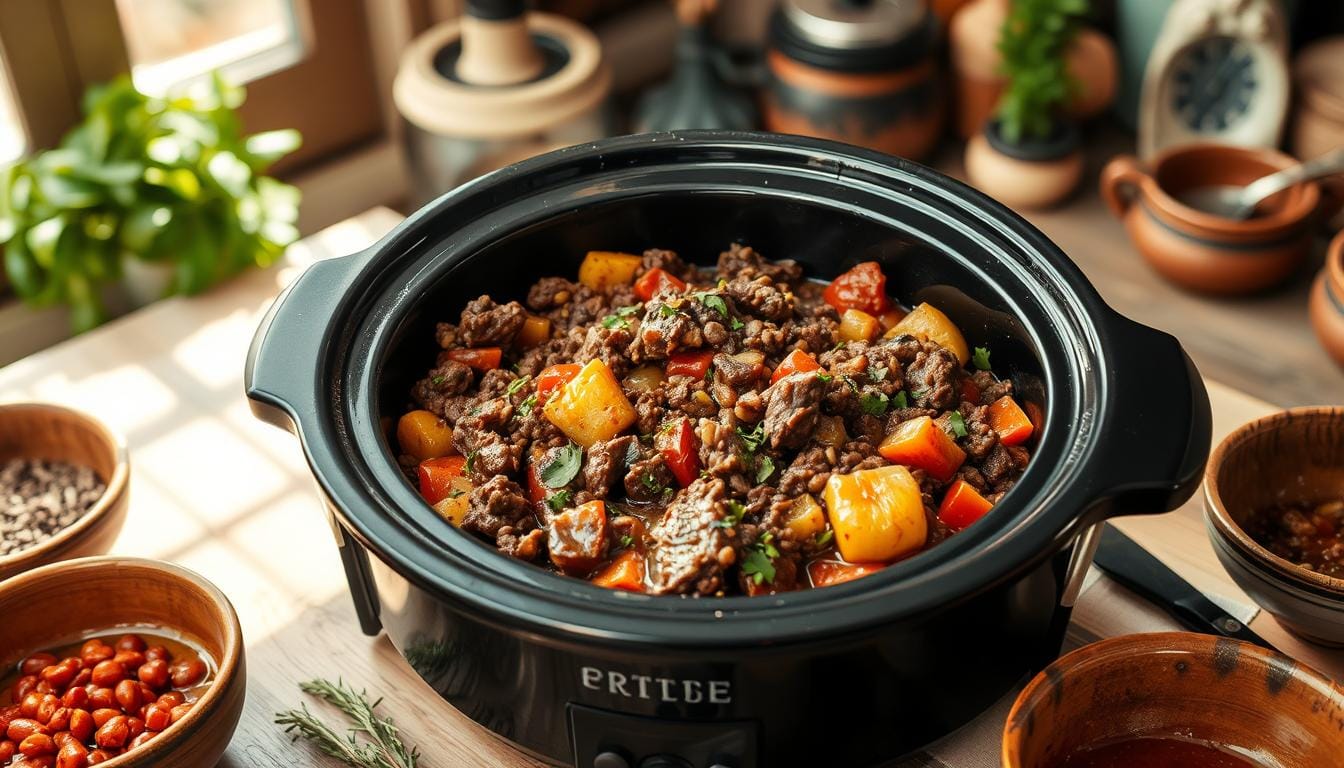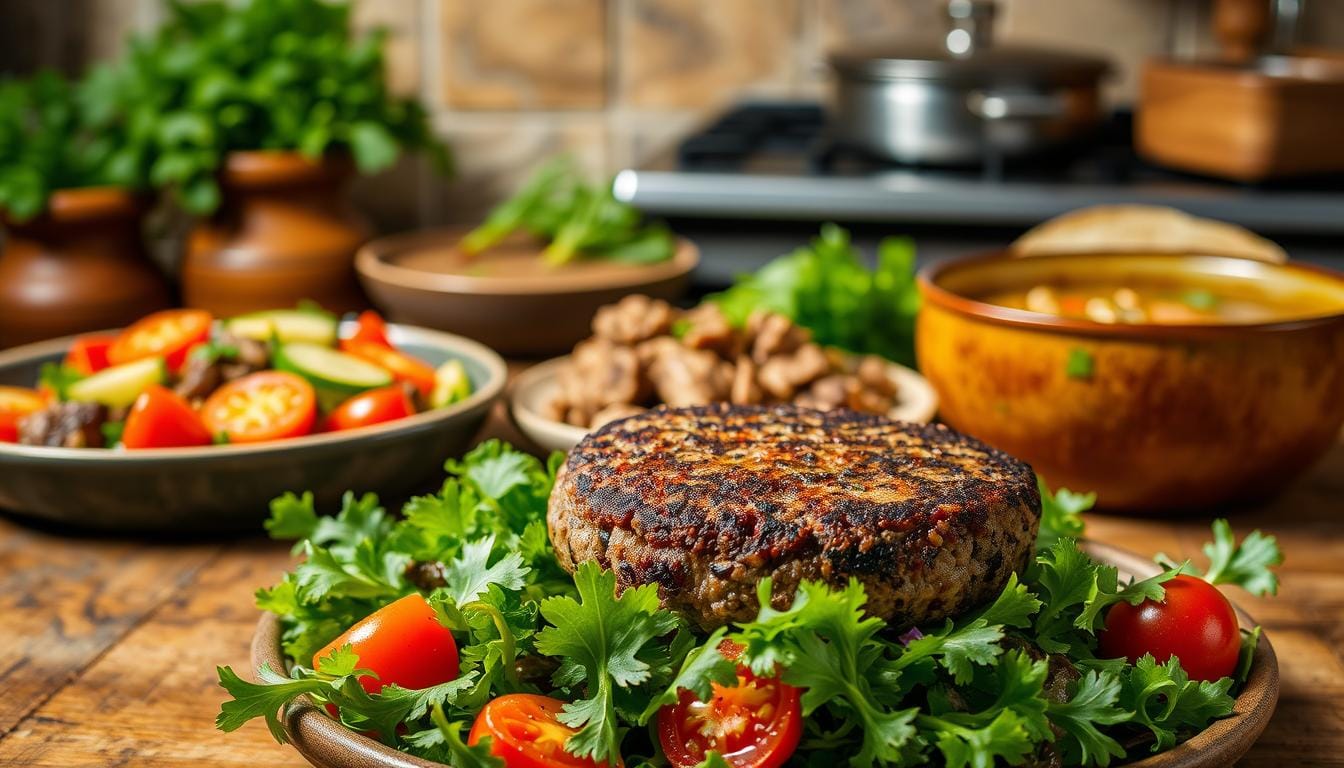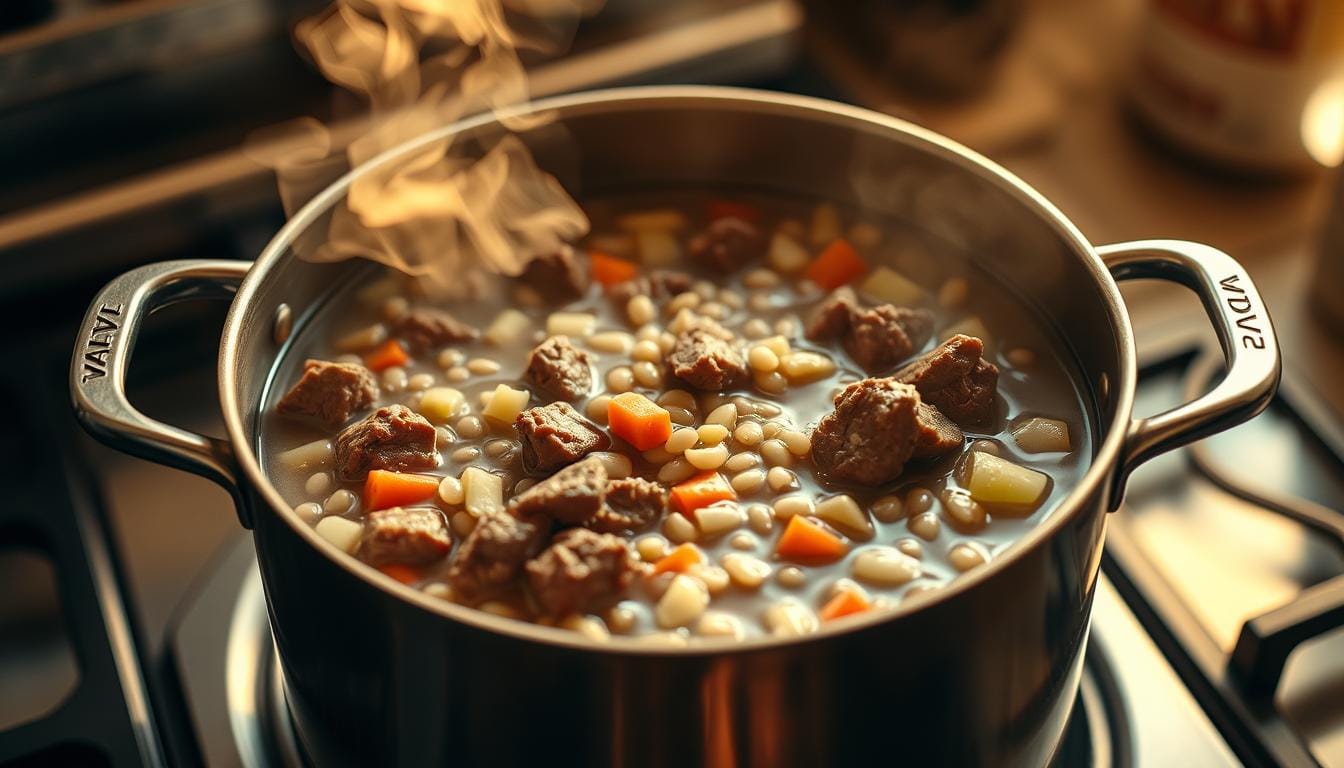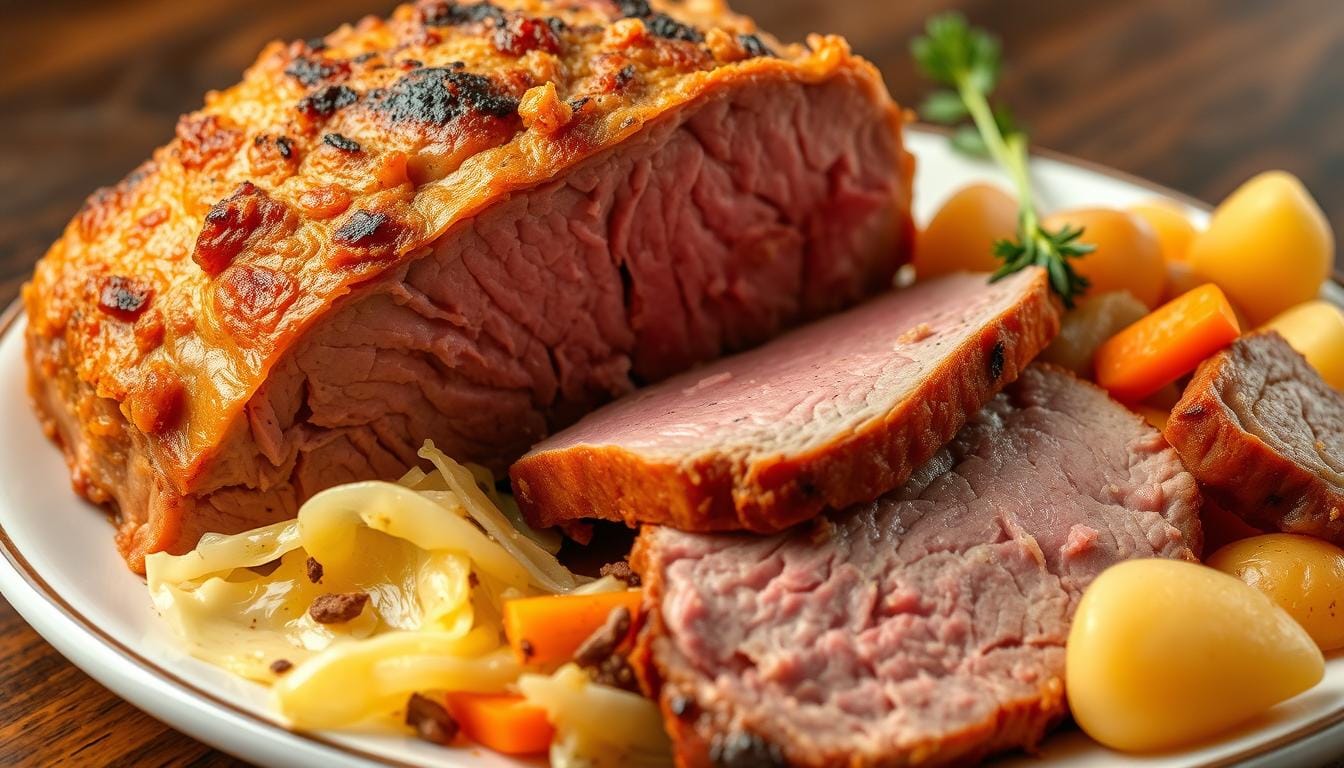Delicious Beef Ribs Recipe: Fall-Off-The-Bone Tender
Table of Contents
Imagine a summer afternoon with the grill hot and the smell of beef ribs everywhere. A great beef ribs recipe can turn a simple meal into a special event.
Beef ribs are more than food; they’re a feast for the senses. They’re perfect for anyone who loves to grill or cook at home. Learning to make tender beef ribs can make you a better cook and impress your guests.
This guide will teach you how to make beef ribs that are so tender, they’ll fall off the bone. We’ll cover everything from picking the right cut to getting that perfect tenderness. You’ll learn how to make a beef ribs recipe that your family will love.
Get ready to learn how to make the most delicious, tender beef ribs you’ve ever had. Your cooking adventure begins now!
Introduction to Beef Ribs
Beef ribs are a tasty and versatile meat cut loved by many in the U.S. They offer a rich culinary experience that’s more than just cooking. Whether you’re a pro chef or a home cook, learning about beef ribs can improve your cooking and meal prep.
What Exactly Are Beef Ribs?
Beef ribs come from the rib section of cattle. They have different areas on the cow, each with its own traits. Beef short ribs and beef back ribs are two favorites, known for their unique flavors and textures.
Types of Beef Ribs to Know
- Plate Short Ribs: Meaty and rich, found in the lower chest area
- Chuck Short Ribs: Located near the shoulder, with intense marbling
- Beef Back Ribs: Taken from the top of the rib cage, leaner and tender
Nutritional Powerhouse
Beef ribs are not only tasty but also full of nutrients. They offer:
- High-quality protein for muscle development
- Important minerals like zinc and iron
- B-vitamins for energy metabolism
Knowing about beef ribs can change how you cook. Each type of rib gives a different taste experience, pleasing many palates.
Choosing the Right Cut of Beef Ribs
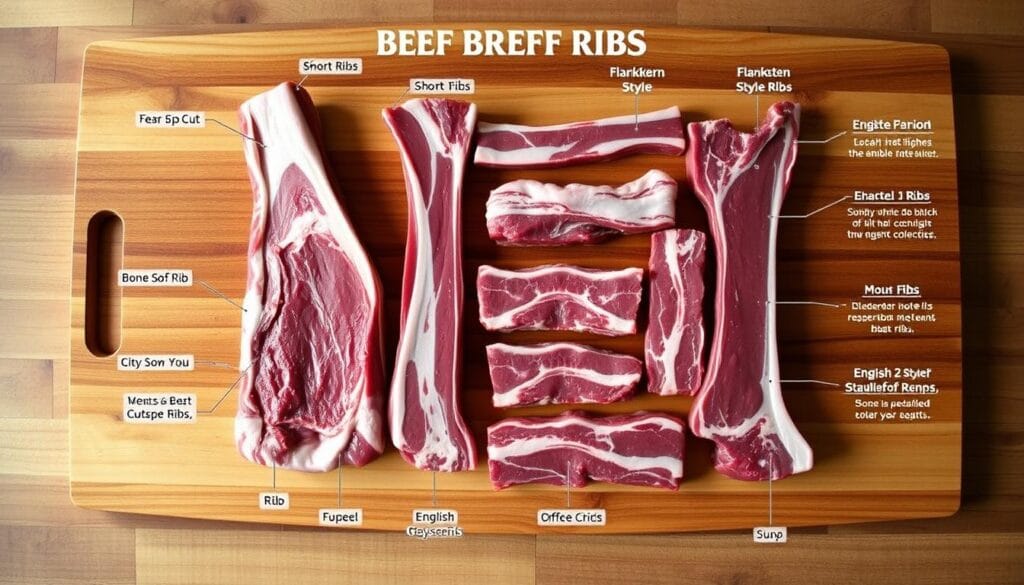
Choosing the right beef ribs is key to a great dish. Knowing the different cuts and their qualities will make your meal a hit. It will impress your guests and satisfy your taste buds.
Beef ribs have various cuts, each with its own flavor and tenderness. Your choice greatly affects the taste and texture of your dish.
Spare Ribs vs. Back Ribs: Understanding the Difference
It’s important to know the difference between spare ribs and back ribs. Here’s a quick comparison:
- Spare Ribs: Larger, meatier, and taken from the belly area
- Back Ribs: Leaner, more tender, and sourced from the rib cage behind the shoulder
Factors to Consider When Selecting Beef Ribs
When picking beef ribs, consider these factors:
- Meat Quality: Look for well-marbled ribs with consistent fat distribution
- Color: Fresh beef ribs should have a bright red appearance
- Thickness: Uniform thickness ensures even cooking
| Cut Type | Meat Content | Recommended Cooking Method |
|---|---|---|
| Spare Ribs | High meat content | Slow smoking or braising |
| Back Ribs | Leaner meat | Grilling or oven roasting |
Pro tip: Always buy beef ribs from a trusted butcher. They can help you pick the best cut for your recipe. Fresh, high-quality ribs are essential for a great dish.
Essential Ingredients for Beef Ribs
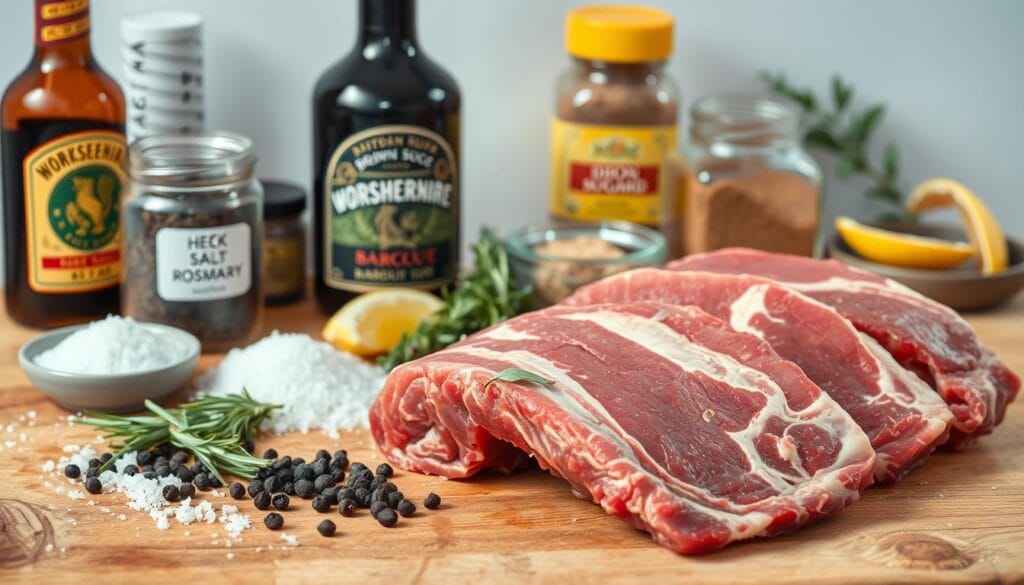
Making delicious barbecue beef ribs begins with the right ingredients. The perfect beef rib rub can turn simple meat into a feast for the senses. It will wow your guests and excite your taste buds.
To make amazing barbecue beef ribs, you need the right mix of ingredients. These ingredients boost flavor and make the meat tender.
Basic Ingredient Checklist
- Beef ribs (preferably high-quality, well-marbled cuts)
- Kosher salt
- Coarse black pepper
- Paprika
- Garlic powder
- Brown sugar
Optional Ingredients for Flavor Enhancement
Take your beef rib rub to the next level with these extra ingredients:
| Category | Ingredient Options | Flavor Profile |
|---|---|---|
| Spices | Chili powder | Adds heat and depth |
| Herbs | Dried thyme | Provides earthy undertones |
| Sweet Elements | Smoked paprika | Introduces subtle smokiness |
When making your beef rib rub, balance is crucial. Try different mixes to find a flavor that matches the beef ribs’ natural taste.
Pro tip: For authentic barbecue beef ribs, let your rub sit on the meat for at least an hour before cooking. This lets the seasonings soak in, making the meat more flavorful and tender.
Preparation Steps for Beef Ribs
Getting ready for delicious beef ribs needs focus and the right cooking method. Whether you’re making smoked, oven-baked, or grilled ribs, preparation is crucial. It’s what makes the dish truly tasty.
Marinating Your Beef Ribs
Marinating turns simple beef ribs into a flavorful feast. Begin by picking a marinade that matches the meat’s richness. Follow these key steps:
- Clean the ribs well
- Pat the meat dry with paper towels
- Apply a good rub or marinade
- Marinate the ribs in the fridge for 2-8 hours
Preparing Your Cooking Surface
Preparation is key for great grilled or oven-baked ribs. For grilling, make sure your grates are clean and lightly oiled. For the oven, preheat to the right temperature and use a lined baking sheet.
Cooking Techniques Comparison
Each cooking method has its own benefits for beef ribs:
- Smoking: Offers deep flavor and tender meat
- Oven-Baking: Provides consistent heat and easy temperature control
- Grilling: Creates a delicious char and crispy outside
Pro tip: No matter the method, slow cooking makes ribs tender and flavorful.
Cooking Times and Temperatures
Mastering slow-cooked beef ribs needs precision in temperature and timing. The secret to tender ribs is understanding how heat changes tough meat into a delicious treat.
Temperature is key for that fall-off-the-bone texture everyone loves. Use low and slow cooking to break down tissues and melt fat.
Recommended Cooking Temperatures
- Smoker: 225-250°F (107-121°C)
- Oven: 275°F (135°C)
- Grill (indirect heat): 250°F (121°C)
Ideal Cooking Times for Tender Ribs
| Cooking Method | Cooking Time | Internal Temperature |
|---|---|---|
| Smoker | 5-6 hours | 195-203°F (90-95°C) |
| Oven | 4-5 hours | 190-200°F (88-93°C) |
| Grill (indirect) | 4-5 hours | 195-205°F (90-96°C) |
Pro tip for perfect slow-cooked beef ribs: Use a meat thermometer to check internal temperature. Patience is key – rushing will make the meat tough, not tender.
Remember, different ribs might need slight cooking time changes. Always let your ribs rest for 15-20 minutes after cooking. This ensures they are at their most tender and flavorful.
Serving Suggestions and Pairings
Your perfectly cooked beef ribs recipe deserves amazing sides. Classic Southern sides make your meal unforgettable. They impress everyone at the table.
Choose sides that mix textures and tastes. Creamy coleslaw is a cool contrast to the smoky ribs. Baked beans with brown sugar add sweetness. Crispy cornbread is perfect for soaking up sauce.
Roasted veggies like corn on the cob or grilled asparagus add variety. They complete your plate.
Classic Side Dishes
The right sauce can elevate your beef ribs. Homemade Kansas City-style barbecue sauce is sweet and tangy. It brings out the meat’s flavors.
For a spicy twist, try Texas-style chipotle sauce. It adds depth to the ribs. Serve these sauces on the side for guests to choose.
Sauce and Beverage Recommendations
Choose drinks that match the bold flavors of your ribs. Red wines like Zinfandel or Syrah pair well. Craft beer fans might like a hoppy IPA or amber ale.
For non-alcoholic drinks, sweet tea or sparkling lemonade are great. They refresh and balance the ribs’ richness.
FAQ
What are the best types of beef ribs for smoking?
Beef plate short ribs and chuck short ribs are top picks for smoking. They have lots of marbling and fat, making the meat tender and tasty. Back ribs are leaner and need careful watching to avoid drying out.
How long does it take to cook beef ribs to achieve a tender texture?
To get tender beef ribs, cook them low and slow. Aim for 5-6 hours at 225-250°F (107-121°C). This breaks down connective tissues, making the meat tender. Always check the meat’s internal temperature with a thermometer, aiming for 203°F (95°C).
Do I need to remove the membrane from beef ribs before cooking?
Yes, remove the membrane from the back of the ribs. This membrane stops seasonings from getting in and can make the ribs chewy. Use a butter knife to lift a corner, then pull it off with a paper towel. This makes the ribs more flavorful and tender.
What’s the best way to season beef ribs?
A good beef rib rub has salt, black pepper, garlic powder, onion powder, and paprika. You can add brown sugar, chili powder, or dried herbs for extra flavor. Rub the ribs generously at least an hour before cooking, or the night before. Use mustard or olive oil to help the rub stick.
Can I cook beef ribs in the oven if I don’t have a smoker?
Yes! Oven-baked beef ribs are just as tasty as smoked ones. Wrap the ribs in foil and cook at 275°F (135°C) for 3-4 hours. For smoky flavor, add liquid smoke to your rub or use smoky barbecue sauce. Then, broil or grill for a few minutes to caramelize the exterior.
How do I know when beef ribs are fully cooked?
Check doneness with a meat thermometer, aiming for 203°F (95°C). You can also do the bend test: the ribs should bend easily. The meat should pull back from the bones, and a fork or toothpick should go in with little resistance.
What are the best side dishes to serve with beef ribs?
Classic barbecue sides are great with beef ribs. Try coleslaw, baked beans, corn on the cob, mac and cheese, or potato salad. Cornbread is a traditional favorite that pairs well with the meaty flavor of beef ribs. For a lighter option, a crisp green salad or roasted vegetables can balance the meal.

